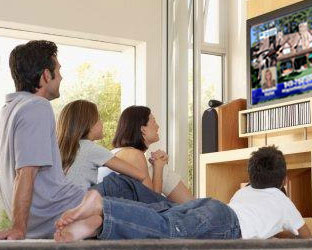 They’re beginning to notice the potential of smart and/or connected TVs to access Internet content and bring it to the big screen, according to a white paper, “Smart TV and Multi-screen Advertising: Prospects for 2012,” from Lisa Roner and Tom Sapsted for Smart TV Insider.
They’re beginning to notice the potential of smart and/or connected TVs to access Internet content and bring it to the big screen, according to a white paper, “Smart TV and Multi-screen Advertising: Prospects for 2012,” from Lisa Roner and Tom Sapsted for Smart TV Insider.
“With the new opportunities on Smart TV and across multiple devices, broadcasters, content owners, TV manufacturers and advertisers are changing their strategies, adapting to new technologies and offering new services,” the report said, adding it would mean “increased exposure for advertisers (and) new ways to reach the masses.”
The analysis addresses the major technical challenges, investment opportunities
and innovations that are changing advertising in the connected era. With smart TV revenues set to reach $95 billion by 2015 and 15 billion video enabled connected devices predicted by 2020, advertising on Smart TV and across multiple platforms will inevitably mean big business. The opportunities are endless. That being said, advertisers, broadcasters and technology vendors are exploring this nascent industry only tentatively.
Last year alone $29 billion was spent on TV advertising. On online video advertising a further $3.1 billion was spent. Online video ads are expected to grow 20% in 2011 and then average 20% global growth through 2016 [Magna Global].
Huge problems hinder the growth of the Smart TV advertising market. The move away from linear broadcasting means the industry must adapt. With the new opportunities on Smart TV and across multiple devices, broadcasters, content owners, TV manufacturers and advertisers are changing their strategies, adapting to new technologies and offering new services. This can only mean
increased exposure for advertisers- new ways to reach the masses.
Research covering 124 advertisers across 16 major industries discovered that there is experimentation with advanced ad placements [Forrester]. Nearly half of the advertisers said they were testing or planning to test advanced TV ad placements in the next 12 months via platforms such as video on connected
TVs. All the signs are there: advertisers are now tuning into the opportunities.
Despite these remarkable figures uptake with Smart TV and multi-screen advertising has been tentative at best. Fragmentation is a massive deterrent for investment, increasing scale and reach needs to be a priority, creating an effective business model is now vital.
Questions need to be answered. How to form effective partnerships be formed between advertisers, broadcasters and the leading technology players? How can we overcome a fragmented market? How can we build a business model that
suits both advertisers and publishers alike? What can be done to get the reach and targeted style commercials that advertisers’ desire? What will the tablet mean for broadcasters and advertisers? How do we get investment from the major brands?
The Smart TV and Multi-screen Advertising Summit takes place on 13-14 November in San Francisco. Ahead of Summit, Smart TV Insider spoke to four speakers who have given their thoughts:
Michael Bologna, Director, Emerging Communications, GroupM: “Advertising today operates fairly consistently across the majority of “traditional” media outlets. In most cases, media is planned using the content as the surrogate for the audience and messages are distributed according to an advertiser’s reach and frequency goals. There are creative and economic standards for each channel that keep the business operating on course. Unfortunately, similar standards and processes do not yet apply when talking about “Smart” TV’s. As with any “Connected” device, a “Smart TV” presents significant advertising potential once scale is achieved and some of the complexities are reduced and potential conflicts resolved. In an ideal world, the advertiser would have access to the entire footprint of “Smart” TV’s regardless of the manufacturer; this would allow them to seamlessly insert their message to reach the appropriate audience within that national segment. We would then overlay the necessary interactive features which would be consistent across the desired footprint. This is not the case today, as advertisers must cut specific deals with each manufacturer (Samsung, LG, Panasonic, Sony, etc.) and cobble these together to generate scale.
This process is complex, time consuming, and costly, and it is currently hindering the short term growth of the medium. These challenges are consistent with all of the Advanced Television business, where the primary technology and capabilities reside within each system. Advanced advertising on Comcast is different from advanced advertising on TimeWarner versus Direct TV versus Dish. In many cases, advertisers express interest in the benefits of advertising on these platforms, but are ultimately discouraged from campaign execution because it is costly to build the applications for all the different systems. This is the key hurdle we are faced with today in Smart and/or connected televisions.
Over time, this will improve. Technology will evolve, creating a consistent platform and multiple consistent platforms equal scale. This evolution has already begun with companies like YuMe and Rovi that have cut deals with several of the Smart TV manufacturers to represent their inventory and act as an insertion engine for deploying an advertiser’s message consistently across more than one manufacturer.
Dietrich von Behren, VP, Digital Media & Investments, A&E Television Networks: Technical challenges are actually secondary to marketplace pressures. The primary issue for Smart TV and cross-platform advertising is audience size. While digital consumption is growing rapidly, the numbers are still greatly outweighed by broadcast. However, given the adoption curve of connected devices and future projections, advertisers will soon see more viable sales opportunities and should start considering fully integrated campaigns.
Secondly, as the Smart TV and multi-screen opportunity develops, the ad industry and content distributers will define standards and measurements which will both improve and encourage growth around social engagement and experience.
Kemal Altintas, Senior Manager Business Development and Product Innovation, LG Electronics: Generally, there are no major technical difficulties right now. It’s more an issue that there are not many examples yet. This lack of experience is the biggest challenge right now. But in terms of technical difficulty, making
the two devices talk to each other is possible today. Two-way communication channels on the cloud and syncing to applications and devices is possible. So I don’t really see a major challenge in terms of technology. If anything, it’s about settling on a standard technology that everyone agrees upon. But otherwise, I think the technology is almost there.
Wendell Wenjen, Director of Strategic Alliances, LG Electronics: In terms of the Smart TV based advertising, I concur that there are very few major technical challenges. LG launched an advertising service last November on our Smart TV platforms. And in March, we launched the second generation of that. Other manufacturers have done similar initiatives.
We are continuing to work on new types of ad units that are more engaging and more immersive. There are some technical improvements that allow multiple video screens to be shown simultaneously, but we’re in the very early stages of developing these types of ad experiences. I think that as advertisers and
agencies get more experience in trying out different concepts, and testing and measuring their effectiveness at audience engagement and increasing brand awareness, those kinds of experiences will be more common.





